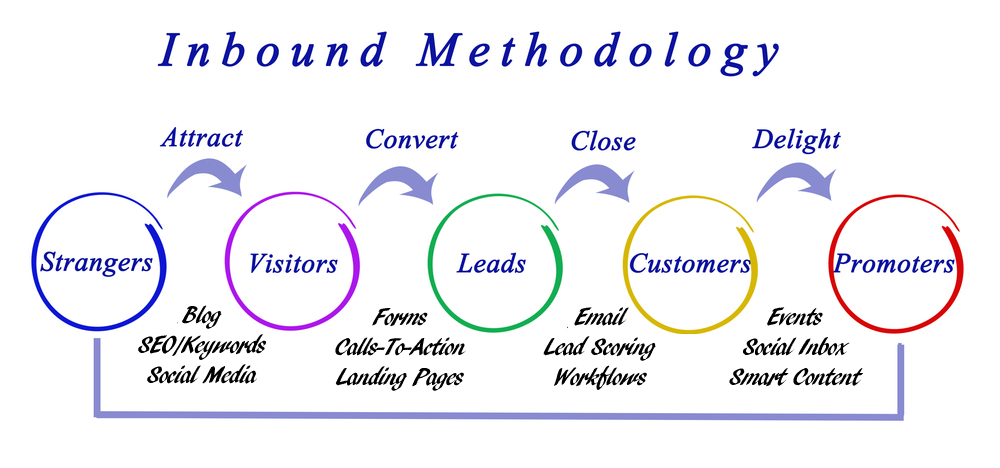
Be Careful What You Measure. You Might Just Get It.
Are you measuring the right steps of your Digital Inbound Marketing programs? If not, you may be getting a number, because you started to measure it, that does nothing to improve the quality of the leads you get.
Here is the classic example of the Inbound Methodology as described by HubSpot.
Attract/Convert/Close/Delight
There are books, white papers, classes, and even certifications on the Inbound Methodology. Today we’d like to talk about one issue, measurement, and a potential pitfall that can occur. That is measuring only one target out of context of the entire process. That can lead to an incorrect feeling of success when not understanding the impact of the upstream and downstream parts of the process. There are many places where this can occur. Here are two examples to illustrate how the out of context standalone measurement can trip you up.
Examples of Measuring one step vs all of them.
- Measuring only an early step, like Attract – Web site visitors
- Measuring only a late step, like the Close step, or taking the customer order
Measuring only an early step, like Attract – Web site visitors
The Digital Marketing team creates a target of x visitors per month to the web site. You currently have a small amount. You do need to get more in this step of the process so that more flow through to the next step, converting them to leads (not customers, they are still a lead in the consideration stage of their buyer’s journey. But they are qualified, meaning they are aware they need something you have and considering you might be a fit. They still need to be closed and become a customer).
This is a good thing in the context of the entire flow. It is not The Only Objective. Often, the marketing team gets focused on getting thousands of visitors and calls it a day “Hey, we made our number!” And then perhaps no orders are popping out the back end. Where’s the disconnect? Does the Digital Marketing team care? Well of course they should.
If a significant percentage of the visitors then convert to be Leads, that’s great. If they don’t, they drop out here, then what good is the big number? It is no good. In fact, it might end up being a negative. if you attract many visitors, only for them to find out your product is not good for them, or the site is painful to navigate (poor design, broken links), or they can’t find their answers, or any number of issues, you may get a bad reputation, which is worse than no reputation.
My favorite, pre-Internet version of this story is “The Smile and Dial”. When the CEO/CFO of a company says, “Hey, every sale began with a phone call, so every sales person needs to make 10 cold calls a day!” And they start to measure that. Guess you what you get? 10 phone calls a day per sales person. Wow! But if they’re not qualified and managed in the context of the company value proposition and Inbound Stream, then you probably get 49-50 “fake” calls per week that do not produce any results. It wastes the time of a valuable sales team. Don’t let your Digital Marketing strategy get hijacked by a wasteful Smile and Dial.
Measuring only a late step, like the Close step, or taking the customer order
At then end of the day, you’re trying to get Sales, take orders, right? Of course, this is everyone’s objective. However, if you only count that and have no insight into the previous steps, you will not ever find out how it is really working. Worse still, if you’re not getting the amount of orders you want, where is the drop? Where are people leaving? Is it a rational target in the context of the entire chain?
If you only focus on the last step, you risk not doing anything to improve the earlier steps.
For example, if you expect to close 100 orders a month (for whatever reason you came to that conclusion), and there are only 50 visitors a month in total to your web site, how can you possibly expect to get 100 orders a month? This is just simple math. If you have this issue (do you know if you do or not?), then you need to work on the upstream targets first. Then you can see the effect on conversion through the entire process. Perhaps you need to work on the Attract stage more, by adding SEO/Keywords, or driving traffic using social media.
More than likely, as you get better at your digital marketing, you will have more visitors than close to become leads or customers (orders). What is the current rate? Is it 1%, 10%, 50%? Virtually no one attains high numbers like 50% or higher. If you got 10%, then your message and product value proposition is probably very good, and your web site is probably useful and easy to use.
Let’s go back to our example. If you wanted 100 orders a month, and you close at a 10% rate, you need 1,000 leads a month (a visitor is not a lead). Simply, a lead is converted from a visitor after they came to your site and performed the action you intended to get them into the consideration stage. For example, they clicked on “Please have a salesperson contact me, here is my contact information,”, or “Please send me your fantastic white paper about my problem, here is my contact information.”
What is your conversion rate of visitors to leads? If that is 5%, then you need 20,000 visitors per month! Does your Digital Marketing program have any chance to get 20,000 visitors per month? If not, then likely your original 100 orders per month is not reasonable either.
Then after they have purchased your product, do they become a promoter? Did you please them so much, they are delighted? Can they be a repeat customer? Can they recommend you to the next prospect? Focusing just on the order, you may forget that this could play a huge factor in improving all the upstream statistics. Some companies focus on just this measure, you may have heard of the net promoter score. Again, a useful measurement in context of the overall process, but useless on its own as the only measurement.
Does your business “hand off” a lead from the Marketing programs to the Sales teams to close? If so, they are still part of the entire process, even though it goes off line out of the Digital Marketing team. You still need definitions, targets, measurements and improvements. Do you have an agreement between the Marketing and Sales teams on what Marketing provides as a qualified lead, and what Sales thinks is qualified for them to be in their funnel? If not, that needs to be accomplished as soon as possible to avoid finger pointing.
Recommendation
Consider your business in the entire Inbound Methodology. Stake out initial targets at each phase. Measure all the phases, not just one. Look for actions that can improve one step of the process. Work on that one, measure again? If it worked, do more. If it didn’t, then you need to try other methods. If the targets are met, raise the bar, try to get more strangers in the front, try to improve the conversion rates in various areas. There is not one solution. There are many.
Measurement is key. If you can’t measure it, you can’t make it better (or how would you know if it was better anyhow?). Quantifiable analytics are the key to any Digital Marketing program.
Summary
Be careful what you measure, you might just get it, if out of context with the entire process end to end.
So, map out your business using the Inbound Methodology. Set targets. Measure every step of the way. Don’t be afraid to get started. Continuous improvement is the most important outcome. It is a marathon, not a sprint.






